on the tutorial promgrammingWithObjectiveC.
The following code make me confuse:
Custom type definitions are particularly useful when dealing with blocks that return blocks or take other blocks as arguments. Consider the following example:
void (^(^complexBlock)(void (^)(void)))(void) = ^ (void (^aBlock)(void)) {
...
return ^{
...
};
};
The complexBlock variable refers to a block that takes another block as an argument (aBlock) and returns yet another block.
Rewriting the code to use a type definition makes this much more readable:
typedef void (^XYZSimpleBlock)(void);
XYZSimpleBlock (^betterBlock)(XYZSimpleBlock) = ^ (XYZSimpleBlock aBlock) {
...
return ^{
...
};
};
my understan the rewriting code :
 but I can't understand the source code:
but I can't understand the source code:
void (^(^complexBlock)(void (^)(void)))(void) = ^ (void (^aBlock)(void)) {
...
return ^{
...
};
}
in my understand, it should be:
(void (^) (void)) (^complexBlock) (void (^)(void) = ^ (void (^aBlock)(void)) {
...
return ^{
...
};
};